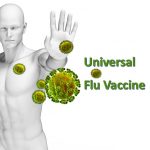 Officials from the National Institute of Allergy and Infectious Diseases published a roadmap for developing a universal influenza vaccine that protects not only against seasonal influenza but also virus strains that can cause pandemics.
Officials from the National Institute of Allergy and Infectious Diseases published a roadmap for developing a universal influenza vaccine that protects not only against seasonal influenza but also virus strains that can cause pandemics.
The NIAID officials said the plan, which focuses on knowledge gaps in three major areas of research, will be used “as a foundation for future investments in influenza research and will support and coordinate a consortium of multidisciplinary scientists focused on accelerating progress toward this goal.”
Essentially, NIAID director Anthony S. Fauci, MD, said, the plan identifies fundamental scientific questions critical to developing a universal influenza vaccine and outlines how to fill gaps in knowledge through basic research projects. The goals include finding better antigenic targets for future vaccines and testing adjuvants and alternative delivery methods.
“It’s kind of a scientific blueprint that also goes well beyond the science and into development,” Fauci told Infectious Disease News.
“A Universal Influenza Vaccine: The Strategic Plan for the National Institute of Allergy and Infectious Diseases” was published Wednesday in TheJournal of Infectious Diseases. It included recommendations from a working group of scientists from academia, industry and the government that was convened by the NIAID last June — months before the start of a severe influenza season in the United States that has been dominated by a virus, H3N2, that is associated with relatively severe illness and is notoriously difficult to defend against.
The group said a universal vaccine should be at least 75% effective against symptomatic influenza infection, protect against groups I and II influenza A viruses — with influenza B viruses being a secondary target — and provide protection that lasts at least 1 year and preferably through multiple seasons.
Under the plan outlined by Fauci and colleagues, the NIAID would focus its resources on three areas of research: improving the understanding of transmission, natural history and pathogenesis of influenza infection; precisely characterizing how protective influenza immunity occurs and how to tailor vaccination responses to achieve it; and supporting the rational design of universal influenza vaccines, including designing new immunogens and adjuvants to boost immunity and extend the duration of protection.
The NIAID spent an estimated $64 million on universal influenza vaccine research in fiscal year 2017 but could have a lot more money to work with in the future if lawmakers pass the Flu Vaccine Act, a bill introduced recently in the U.S. Senate that calls for a federal investment of $1 billion over 5 years for the NIAID to create a universal influenza vaccine.
Sen. Edward J. Markey (D-Mass.), who introduced the legislation, applauded Fauci and the NIAID “for their commitment to ending this centuries-old scourge with a 21st century plan.”
“While I believe our ultimate goal should be creating a flu vaccine that could be administered once or twice and provide a lifetime of protection, NIAID’s strategic plan represents an actionable and achievable proposal to mitigate the dangerous effects of the flu,” Markey said in a statement. “I look forward to working to secure the resources the NIAID needs so that one day, the flu will be relegated to the history books.”
Fauci said the NIAID plan is not necessarily dependent on additional funding and was developed independent of the proposed legislation.
“We don’t want to get ahead of ourselves,” he said. “We don’t have the money yet. We might not ever get the money. If we do, it will be well used to implement the strategic plan. If we don’t get new money, I will have to reprioritize money that we already have, because as I’ve stated publicly multiple times, I’m making the development of a universal influenza vaccine one of the top two or three priorities over the next couple of years in our institute.”
The foremost reason for developing an influenza vaccine that offers broader and longer lasting protection has been to reduce the impact of seasonal influenza. According to early estimates, this season’s influenza vaccine has been just 36% effective, including only 25% effective against H3N2.
Several factors can lead to low seasonal vaccine effectiveness, including the method of growing vaccine viruses in eggs and targeting a part of the virus — the globular head of the hemagglutinin surface protein — that frequently evolves. Selecting vaccine viruses largely depends on predicting which viruses will circulate the following season. Next season’s vaccine will include a different H3N2 component that has performed better against recent viruses.
“The current strategy for seasonal influenza vaccination keeps us at least 1 year behind this ever-evolving virus,” Fauci and colleagues wrote.
They said the current strategies used to produce vaccines against potential pandemic influenza strains can lead to the stockpiling of vaccines that may never be used, such as what happened with the stockpile of H7N9 vaccine, which had to be replaced after the virus split into two strains, including one that was not susceptible to the old vaccine. – by Gerard Gallagher
Source: Healio

















